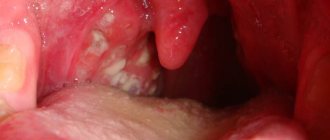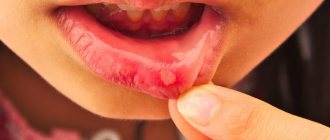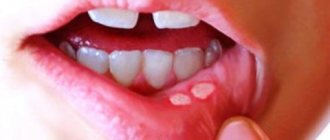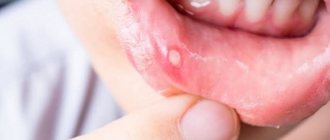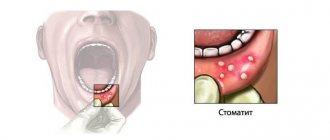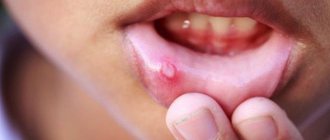Stomatitis is an inflammation of the mouth (but can also develop on the tongue and lips) that is most often diagnosed in children. Stomatitis in adults is usually a consequence of the introduction of viruses into the oral mucosa. In addition, this disease can occur in the presence of a number of other diseases, due to decreased immunity. For dentists, diagnosing and treating stomatitis in the mouth does not cause any difficulties, while attempts to get rid of the disease on their own can lead to unpleasant consequences
What does aphthous stomatitis look like?
Aphthae occur on the inside of the cheeks or lips, under the tongue, at the base of the gums, or on the soft palate.
https://img.medscapestatic.com/pi/meds/ckb/75/43075.jpg
They can be confused with manifestations of herpetic infection , but the latter usually appears at the red border of the lips, rarely in the oral cavity - usually on the gums or hard palate.
Aphthae first look like red bumps (papules), which then quickly turn into ulcers, surrounded by a red rim and covered with a gray-yellow coating (exudate). 1-2 days before the appearance of aphtha, there may be a local burning sensation of the mucous membrane.
Sometimes the child or family members notice what often triggers the appearance of aphthae. Journaling can help with this.
According to American data, about 20% of the population suffered from recurrent aphthous stomatitis at one time or another in their lives.
Most often children suffer and usually these are minor canker sores.
The peak incidence of aphthae is 1-19 years.
Treatment of herpetic stomatitis
Therapy includes the local application of gels with an anesthetic effect, which include lidocaine or articaine (they should be generously lubricated in the mouth).
All kinds of analgesics are prescribed internally, such as ketorol, and, of course, antivirals: Zovirax or acyclovir. Among anti-inflammatory drugs, it is better to choose Cholisal or Metrogyl gel.
Recurrent chronic herpes
In the absence of proper treatment, acute stomatitis becomes chronic - recurrent herpes. The systematic manifestation of single or multiple rashes on the lips, in the mouth area - on the mucous membrane of the eyes, on the palate, genitals and wings of the nose cannot be ruled out.
The appearance of herpetic type rashes is accompanied by a burning sensation. Such a blistering rash subsequently forms merged erosions.
While eating, patients complain of pain and discomfort in the mouth.
The main feature of herpes infection is the likelihood of lifelong infection with the virus.
Types of aft.
Small aphthae is the most common type of aphthae (80-85%). Their size ranges from 1 to 10 mm. Ulcers can appear singly or several at a time (up to five).
Usually heal in 7-10 days.
Large aphthae (10-15%) - more than 10 mm in diameter, can even be up to 3 cm, deeper, take longer to heal (10-30 days).
They may leave scars behind. Very rare in children.
Herpetiform aphthae (5-10%) are small, from 1 to 3 mm, located in groups like herpetic vesicles. They heal quickly, within 10 days. They are not typical for children; they usually occur in the elderly.
The rest of the oral cavity looks normal - there is no inflammation of the gums, redness of the tonsils and pharynx, enlarged and painful cervical lymph nodes.
There is no fever or other general manifestations.
Aphthae in children is manifested primarily by refusal to eat and drink due to pain in the mouth.
The reasons for the recurrence of aphthae are not completely clear; the most popular theory is related to errors in the immune system.
Doctors most often do not find a specific cause of the failure; most likely it is a combination of several factors.
But doctors still have assumptions about some factors.
Acute herpetic stomatitis
As already mentioned, the disease is caused by a virus. Both adults and children are at risk.
So, what is this disease?
The main symptoms of herpetic stomatitis are inflammation of the mucous membrane and aphthae (shallow ulcers and erosions) of the oral cavity.
The disease is highly contagious and can spread quickly to people who have never been infected with the herpes simplex virus.
In most cases, children under three years of age are susceptible to stomatitis, and less often, adolescents and young people.
Initially, there are complaints of deterioration in health with an increase in body temperature from 38°C. As a result of the examination, a slight increase in the cervical and jaw lymph nodes is revealed.
The gums become swollen and red, and small blisters appear filled with clear liquid. The bubbles “burst”, which leads to the appearance of erosions. Aphthae form within 3-5 days.
Patients complain of a feeling of discomfort, burning and itching while chewing food. To ensure that the patient’s condition does not worsen, treatment should be started on time. If the correct therapy is prescribed, the patient will fully recover within 10 days.
If treatment is not followed, then over time, the number of erosions increases, which contributes to the deterioration of the patient’s condition and an increase in body temperature to 39-40.5 ° C.
Herpetic stomatitis manifests itself in mild, moderate and severe stages.
The mild form presents with weakness, malaise and nausea. Temperature is within normal limits. There are a couple of small bubbles in the mouth. The mucous membrane heals quickly.
The moderate form of herpetic stomatitis in patients is manifested by malaise and nausea. Body temperature reaches 38°C. There are a large number of rashes in the mouth.
Nausea, diarrhea and vomiting are the main symptoms of this disease in severe form. Temperature 38.5 - 40°C. There are multiple lesions in the mouth. The presence of all signs of an infectious disease.
To accurately confirm the diagnosis, the dentist prescribes a general blood test and, if necessary, other laboratory tests.
What predisposes to recurrent oral aphthae?
Perhaps the microflora of the oral cavity, herpes group viruses, and maybe Helicobacter pylori, a microorganism that causes stomach and duodenal ulcers, play some role.
Also influence:
- injuries to the oral mucosa
- stress
- deficiency of vitamins B12, B1
- vitamin D deficiency
- zinc deficiency
- poor oral hygiene
- nitrates in drinking water
- Sodium lauryl sulfate is a very popular surfactant in the industry, which is often added to toothpastes for better cleaning and foaming effect.
- food allergies (eg, cow's milk protein) or food hypersensitivity (cinnamon, coffee, chocolate, cheese, figs, pineapple, citrus fruits, some spices)
- non-steroidal anti-inflammatory drugs
It is very important to understand: recurrent aphthae is an independent disease (most often this happens) or a manifestation of some systemic disease.
The latter option is rare, but the doctor should always keep in mind the possibility of this situation.
Symptoms and causes of stomatitis
The manifestations of the disease are clearly visible to the patient, since the inflammation causes him noticeable pain. There are many types of stomatitis, but they have common symptoms.
- In places where the mucous membrane is affected, redness occurs, this area swells and swells.
- The patient is bothered by acute, severe pain, which prevents him from chewing food or talking normally.
- A characteristic sign is the formation of single red ulcers on the mucous membrane with a white filmy dot in the middle.
- Salivation increases significantly, an unpleasant odor appears from the mouth, and gums may bleed.
- In the acute form, enlargement of the lymph nodes and an increase in temperature to 39 degrees are possible.
A huge risk of developing stomatitis appears with a decrease in immunity, against the background of which bacterial and infectious infection of the body occurs. Risk factors are also various systemic diseases: gastrointestinal disorders, problems with hormone production, diabetes, anemia.
The immediate causes are:
- bacteria, fungi, mycoplasma, viral infection;
- complications of infectious ENT diseases;
- allergy;
- injuries, burns of the oral cavity (for example, when eating);
- the presence of massive tartar and plaque;
- poor oral hygiene;
- unbalanced diet;
- medications, toothpastes that significantly reduce salivation.
What systemic diseases can manifest as aphthae?
- Reiter's syndrome
- Behçet's disease
- AIDS
- cyclic neutropenia
- PFAPA syndrome
The gastroenterologist is especially interested in the connection between recurrent ulcers and specialized systemic diseases.
Celiac disease is found in 5% , and for a long time canker sores may be the only manifestation of a reaction to gluten.
Let me remind you that the estimated prevalence of celiac disease in the general population is about 1%.
Enamel defects and aphthous stomatitis in celiac and healthy subjects: Systematic review and meta-analysis of controlled studies
Other important conditions that manifest as canker sores are inflammatory bowel diseases: Crohn's disease and ulcerative colitis.
Extraintestinal Manifestations of Pediatric Inflammatory Bowel Disease: Prevalence, Presentation, and Anti-TNF Treatment
What can help in finding the cause of aphthae?
A conversation sometimes helps to find out whether relatives have important diseases with a family predisposition - celiac disease, Crohn's disease, lupus erythematosus.
During the examination, the doctor can evaluate the general manifestations of the disease (not typical with ordinary recurrent aphthous stomatitis) and check for the presence of ulcers outside the oral cavity.
The simplest laboratory examination is carried out - this is most often enough.
A general blood test may show anemia due to deficiency of iron, folic acid, and vitamin B12.
The level of neutrophils is also assessed - their decrease may be a sign of the rare systemic disease cyclic neutropenia
A high ESR may be a sign of Crohn's disease and ulcerative colitis.
Serum iron levels may be reduced in up to 20% of recurrent canker sores.
Treatment of aphthous stomatitis.
There is no radical and quick treatment.
The main task of the doctor is to fight the pain caused by aphthae. This is especially important for young children, who may refuse to eat or drink due to pain and become easily dehydrated.
For this purpose, local painkillers and drugs are used that form protective films on the aphthae.
The second goal is to speed up healing.
The most popular drugs for healing are anti-inflammatory corticosteroids for aphthae, in rare, especially severe situations - even orally for a short course (prednisolone tablets).
The third task is to avoid or at least reduce the frequency of recurrent aphthae.
For some people, regular intake of vitamins (especially B12), zinc, and iron helps.
Avoiding oral hygiene products containing lauryl sulfate may be helpful.
Together with your dental hygienist, you can consider ways to improve your oral hygiene.
A gluten-free diet will help with celiac disease.
Conclusions:
Aphthae in the mouth recur at some point in life in almost 20% of all people, most often in the second decade of life.
It is difficult to establish a clear and unambiguous reason.
If recurrent aphthae occurs, the pediatrician, physician, or dentist should consider the possibility that rare aphthae are a manifestation of a serious systemic disease.
In such situations, the gastroenterologist must exclude celiac disease, Crohn's disease and ulcerative colitis.
2, total, today
Classification of the disease
Aphthous stomatitis varies in the nature of its course. He can be:
Spicy. It begins with a general malaise, accompanied by an increase in body temperature and apathy. Then single or multiple ulcers appear on the oral mucosa. Aphthae are quite miniature - usually do not exceed the size of a lentil grain. The ulcers are oval or round in shape. They have clear boundaries in the form of a narrow red border. In the center of the aft you can see a grayish-yellowish coating. The appearance of ulcers is accompanied by a burning sensation, and the patient feels pain while eating. Complete independent healing of aphthae occurs within 1–1.5 weeks.
Chronic. Characterized by alternating periods of exacerbations and remissions. Ulcers appear, heal, and after a while appear again. Associated symptoms are not pronounced, and in some periods, even in the presence of aphthae, may be absent. The mucous membrane of the mouth swells from time to time. Chronic aphthous stomatitis is a consequence of acute stomatitis and develops in people with weak local and general immunity or in patients suffering from systemic diseases.
